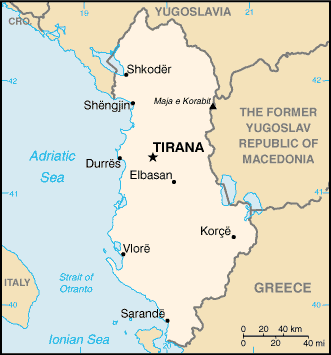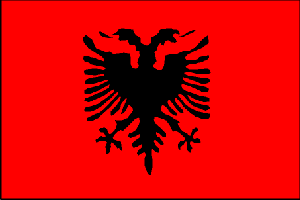
|
Albania
Background:
In 1990 Albania ended 44 years of xenophobic communist rule and
established a multiparty democracy. The transition has proven difficult, as
corrupt governments have tried to deal with high unemployment, a dilapidated
infrastructure, widespread gangsterism, and disruptive political opponents.
International observers judged local elections in 2001 to be acceptable and a
step toward democratic development, but identified serious deficiencies that
should be addressed through reforms in the Albanian electoral code.
1990.
Location:
Southeastern Europe, bordering the Adriatic Sea and Ionian Sea,
between Greece and the Federal Republic of Yugoslavia.
Area: Total: 28,748 sq km water: 1,350 sq km land: 27,398 sq km.
Area - comparative: Slightly smaller than Maryland.
Land boundaries: Total: 720 km border countries: Greece 282 km, The Former
Yugoslav Republic of Macedonia 151 km, Yugoslavia 287 km.
Coastline: 362 km.
Climate and Terrain:
Climate: Mild temperate; cool, cloudy, wet winters; hot, clear, dry summers;
interior is cooler and wetter.
Terrain: Mostly mountains and hills; small plains along coast.
Elevation extremes: Lowest point: Adriatic Sea 0 m highest point: Maja e
Korabit (Golem Korab) 2,753 m.
Natural resources: Petroleum, natural gas, coal, chromium, copper, timber,
nickel, hydropower.
People:
Population: 3,544,841.
Ethnic groups: Albanian 95%, Greek 3%, other 2% (Vlach, Gypsy, Serb, and
Bulgarian).
Religions: Muslim 70%, Albanian Orthodox 20%, Roman Catholic 10%.
Languages: Albanian (Tosk is the official dialect), Greek.
Government:
Government type: Emerging democracy.
Capital: Tirana.
Independence: 28 November 1912 (from Ottoman Empire).
Economy overview:
Poor and backward by European standards, Albania is making
the difficult transition to a more modern open-market economy. The government
has taken measures to curb violent crime and to revive economic activity and
trade. The economy is bolstered by remittances from abroad of $400-$600 million
annually, mostly from Greece and Italy. Agriculture, which accounts for 52% of
GDP, is held back because of frequent drought and the need to modernize
equipment and consolidate small plots of land. Severe energy shortages are
forcing small firms out of business, increasing unemployment, scaring off
foreign investors, and spurring inflation.
Labor force - by occupation: agriculture 50%, industry and services 50%
Industries: food processing, textiles and clothing; lumber, oil, cement,
chemicals, mining, basic metals, hydropower.
Agriculture - products: wheat, corn, potatoes, vegetables, fruits, sugar beets,
grapes; meat, dairy products.
Statistics:
Telephones - main lines in use: 120,000.
Telephones - mobile cellular: 250,000.
Radio broadcast stations: AM 13, FM 4.
Radios: 1 million (2001)
Television broadcast stations: 3.
Televisions: 700,000.
Internet users: 12,000.
Railways: Total: 447 km standard gauge: 447 km 1.435-m gauge.
Highways: Total: 18,000 km paved: 5,400 km unpaved: 12,600 km.
Airports - with paved runways: 3 - with unpaved runways: 8.
Return to Visiting Locations
|

